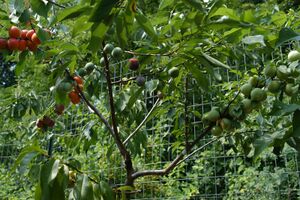Graft
A graft is a union of two plants to grow as one. Grafting is common with apples and other fruit trees to allow desired cultivars to grow on rootstock with desired characteristics. A graft union is place where the two plants meet. Some plants naturally form root grafts with other plants.
An overgraft is a graft made above another graft, and is done to replace a previously grafted species with a new one.
For example, Pyrus ussuriensis is a hardy pear tree grows unpalatable fruit while Pyrus communis 'D'Anjou' grows palatable fruit but has weak roots. Through grafting, a section of branch from a Pyrus communis 'D'Anjou' pear tree can be grafted onto the roots of Pyrus ussuriensis to great a hardy tree that bears desirable fruit.
How to Graft
Grafting should take less than one minute to perform. Practice on scrap pieces of the same species until you have perfected the skill.
- Make a male cut into the rootstock with a grafting tool. The male cut makes a wood peak in the middle of the cutting. Grafting tools are preferred over grafting knives, but whichever tool is selected it should be kept very sharp. This cut should be at least six inches off the ground to prevent the graft from growing roots into the soil.
- Make a female cut into the scion. The female cut has a void in the middle of the cutting.
- The scion only needs to have about three buds on it. Trim off any extra length with a straight cut and use it for another graft.
- Ensure you are allowing the scion to keep the same orientation with your cut. The end closer to the roots on the original tree should still be the end you position closer to the roots during the graft.
- Insert the scion onto the rootstock, lining the cambium of both sections together on an edge. Do not position the two pieces in the center of each other unless that is where the cambium touches. Nutrients travel through the cambium and not the center of the trunk.
- Ensure the male cut is on bottom and the female cut is on top. This allows the water to run off which helps prevent the wood from rotting.
- One benefit of grafting tools over grafting knives are the interlocking cuts it makes which helps keep the scion in position while the graft heals.
- Firmly wrap the union with an elastic band. Start at the top and overlap until the cuts are fully covered. Near the end of the band keep one end open to make a loop to insert the end to prevent unraveling.
- The band keeps the graft firmly in place and protects the wood from drying out.
- The band shouldn't be wrapped too tight, but just enough to allow the band to keep its position.
- Place grafting wax at the top end of the cutting and over the elastic to seal the wood and further protect it from drying out.
- Trim the rootstock of any growth. Revisit periodically to remove any future growth from the rootstock until the scion starts budding and growing.
